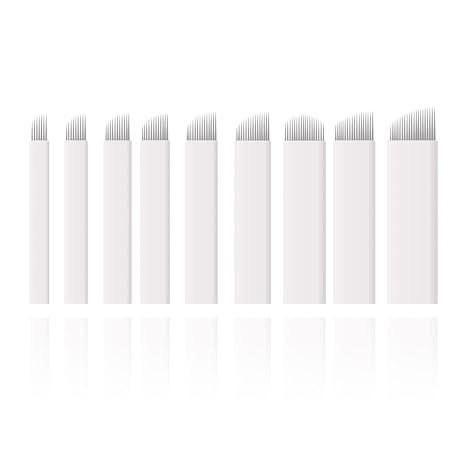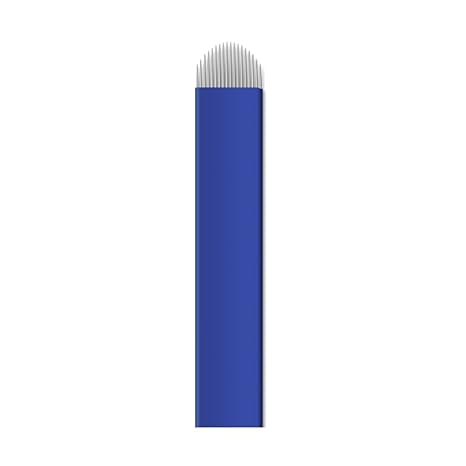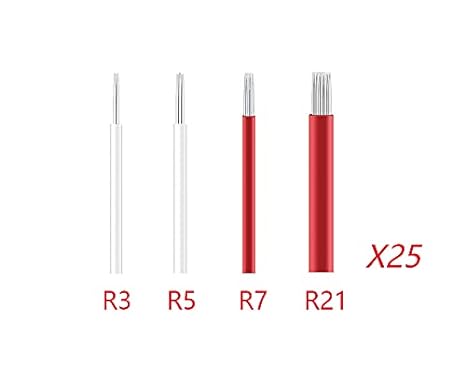Microblading Needles: Understanding Their Role in Brow Artistry

In the world of beauty, microblading has emerged as a standout technique, celebrated for its remarkable precision. What's the secret behind those flawless strokes? The microblading needle. This tool comes in various shapes, each designed for specific effects and outcomes. By understanding these needle types, artists can tailor their approach to each client, ensuring brows that complement and enhance individual facial features. It's a blend of art and science, where the right needle choice is crucial for both the process and the final masterpiece.
Types of Blades
-
Curved Flat (or Round Flat) Needles:

-
- Description: These blades consist of individual needles or pins arranged in a unique angle formation. The design starts with a shorter pin at one end, progressively getting taller towards the opposite end. This design ensures that every pin touches the skin simultaneously, ensuring uniformity in the strokes.
- Usage: Predominantly used in microblading sessions, these blades create lifelike strokes that mimic natural brow hairs. Depending on the number of pins, artists can determine the length and depth of each stroke, allowing for customized designs tailored to different brow areas. Their forgiving nature, especially the soft-based version, makes them ideal for beginners.
-
U-Shaped Needles:

-
- Description: Characterized by their unique design, the pins at each end of this blade are the shortest, gradually increasing in height as they move toward the center. This design means that not all pins can touch the skin simultaneously, allowing for more specialized strokes.
- Usage: These blades are a favorite among seasoned artists for crafting specific designs like bulb strokes (the thicker brow part near the nose), curved baby strokes, and intricate etching techniques. Due to their potential to create longer or misaligned strokes, they're recommended for those with advanced skills.
-
Round Shader Needles:

-
- Description: These blades are distinctive, with pins of identical length bundled together to form a round configuration. This design allows for a more concentrated application, making them perfect for specific shading techniques.
- Usage: Renowned for providing rapid, consistent coverage, these blades excel in fill work. They're adept at increasing shade density, making them versatile for both expansive areas and detailing on thinner brows.
-
Flat Shader Needles:

-
- Description: These blades are designed for precision, featuring pins of uniform height. Their flat configuration gives artists better control, especially when working on intricate designs.
- Usage: Primarily utilized for shading outlines, these blades shine when used on the narrower parts of the brows, such as the tail. Their precision makes them invaluable for filling in slender areas between broader strokes, and they're also adept at creating the popular ombré shading effect.
In conclusion, the microblading needle is more than just a tool; it's the cornerstone of the microblading art. Each needle type brings its unique touch to the procedure, allowing artists to create brows that are as individual as the clients themselves. Understanding and choosing the right needle shape is essential, not only for the technique but also for achieving the desired aesthetic outcome. In the intricate dance of microblading, the needle plays a leading role, ensuring each stroke contributes to the overall beauty and harmony of the final brow design.
Frequently Asked Questions (FAQs)
- Q: What are the different types of microblading needles and their uses?
-
- A: Microblading needles come in various shapes, each designed for specific effects. Curved flat needles are great for creating realistic hair strokes. U-shaped needles are ideal for detailed work like bulb strokes. Round shader needles are used for consistent shading. In contrast, flat shader needles are perfect for precise shading and filling in thinner areas. The choice of needle depends on the desired brow look and the area being worked on.
- Q: How does the choice of microblading needle affect the final look of the eyebrows?
-
- A: The needle type directly influences the hair strokes' thickness, depth, and style. For instance, finer needles create delicate, natural-looking strokes, ideal for a subtle enhancement, while broader needles are used for a more defined, bold look. The needle choice also determines how well the strokes blend with existing eyebrow hairs.
- Q: Are certain microblading needles better suited for specific skin types?
-
- A: Yes, needle choice can vary depending on skin type. For example, softer needles might be better for sensitive or thinner skin to reduce trauma, while harder, more rigid needles might be necessary for oilier skin to ensure proper pigment implantation. The artist's experience and understanding of how different needles interact with various skin types are crucial in this decision.
- Q: Can the wrong needle choice impact the healing process of microbladed eyebrows?
-
- A: Absolutely. Using an inappropriate needle can lead to increased skin trauma, which may result in longer healing times, potential scarring, or uneven pigment distribution. It's essential to use the correct needle type to ensure minimal skin damage and promote even, efficient healing for lasting results.
- Q: How do microblading artists decide which needle to use for each client?
-
- A: Microblading artists consider several factors when selecting a needle for a client. These include the client's natural brow shape, the desired outcome (such as thickness and style of the brows), hair color, and skin type. Artists also factor in their own skill level and familiarity with different needles. The goal is to choose a needle that best achieves the client's desired look while ensuring a safe and effective procedure.
